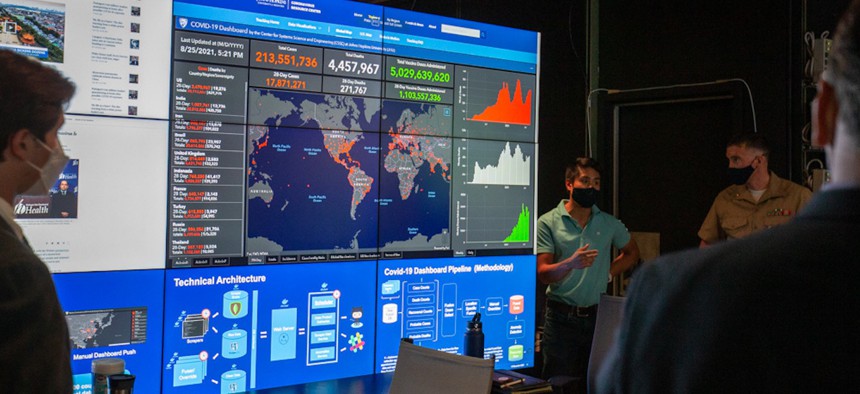
Senior leaders from the Marine Corps Recruiting Command and Manpower and Reserve Affairs visited Johns Hopkins APL, September 22, 2021. The Marines received presentations from the APL staff members on how Machine Learning and Artificial Intelligence can support the Marine Corps’ force design efforts of recruiting and retaining talented Marines. Photo by Sgt. Kenny Gomez / Marine Corps Recruiting Command
New Tech Budget Request is the Defense Department’s Largest Ever
Pursuing China, the Pentagon aims to bump spending for artificial intelligence and 5G.
Efforts to outpace China are driving up the share of Pentagon spending devoted to emerging science and technology, Deputy Defense Secretary Kathleen Hicks said Monday.
The Biden administration is requesting $130 billion for the department’s research, engineering, development, and testing for 2023, nearly 10 percent up from last year’s request. Of that, $16.5 billion will go toward emerging science and technology.
“And we make other significant investments in more mature artificial intelligence and 5G programs,” said Hicks.
The budget request will establish the Office of the Chief Digital and Artificial Intelligence officer, which will oversee the Joint Artificial Intelligence Center, the Defense Digital Service, an expansion of Project Maven, and the Artificial Intelligence Data Accelerator program, among other endeavors. It also allocates $250 million for continued 5G experimentation, with test and evaluation for AI.
This president’s request will be the first to fund the Rapid Defense Experimentation Reserve, a core focus of Defense Undersecretary for Research and Engineering Heidi Shyu, who has sought to field new, experimental technology in the hands of troops sooner, to facilitate better design and quicker deployment.
The request also includes $1.7 billion to develop “next generation air dominance” technology, which could include a sixth-generation fighter, new types of drones, or both. The aim is an arsenal that “outpaces our competitors in the high-end conflict,” said Navy Vice Adm. Ronald Alan Boxall, the director for force structure, resources, and assessment of the Joint Staff.
There’s also money requested for microelectronics, a core research priority for several years now, and cybersecurity pilot programs. Those investments will fund five additional Cyber Mission Force teams within U.S. Cyber Command to “hold targets at risk and defend against malicious actors.” Funding is also requested for cyber ranges for better testing and training. “Finally, this budget lays the foundation for [U.S. Cyber Command] to have ownership of the mission and cyber mission force,” Boxall said.
A large part of that request will go to new software and data tools to link different weapons, platforms, and services, part of the U.S. military’s Joint All-Domain Command and Control vision. That includes $11 billion for network modernization, which Adm. Christopher W. Grady, the vice chairman of the Joint Chiefs of Staff, called “so critical to command and control another one of those functional battles that are so important to us.”
Said Boxall, “this budget also invests in artificial intelligence and machine learning-enabled battle management systems to improve soldier lethality.” Read that to mean: tools to better coordinate data between soldiers, drones, vehicles, etc.; and to make recommendations to commanders based on rapidly-incoming data. “Our investments in multidomain platforms, resilient communication systems, and ground air and maritime delivered fires will increase lethality of our joint force and enhance our ability to deter threats in all domains,” he said.
To fund these tech priorities, the Defense Department is cutting other areas, retiring some ships and cutting the number of stealth aircraft it was seeking to procure. It’s also cutting a controversial sea-launched cruise missile, capable of carrying a variably, low-yield nuclear warhead.
Critics of the missile—among them then-presidential candidate Joe Biden—had argued that it was unnecessary and dangerous. But the planned cancellation drew criticism from the Heritage Foundation’s Tom Spoehr and Fred Bartels. “The previous administration determined that a nuclear-capable sea-launched cruise missile was needed for the purpose of deterring Russian use of nuclear weapons in Europe,” they said in a statement. “Cutting this program leaves the U.S. without an option that is critically needed to deter Russia’s growing nuclear arsenal – and not to mention China, which has a significant advantage in this kind of nuclear capability.”
Overall, said Pentagon comptroller Mike McCord, the proposal keeps money flowing right where it’s really needed: to confront China.
“We had no illusions about Putin as anything but an adversary but if you look long-term, big-picture, whatever you want to call it, China still has the economic power, the military power to really be our primary challenge. We are not taking our eye off that ball in the [National Defense Strategy] or in the budget. But what we did do… we paid the most attention to the things that are foundational like space and cyber and the industrial base that are not a China investment or a Russia investment. They're an investment in our capability across the board,” he said.
NEXT STORY: A Civil War is Brewing In Russian Tech Circles




